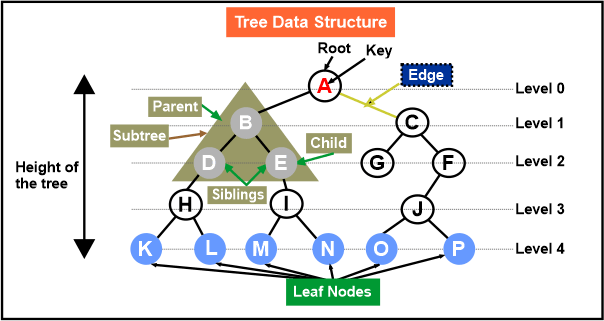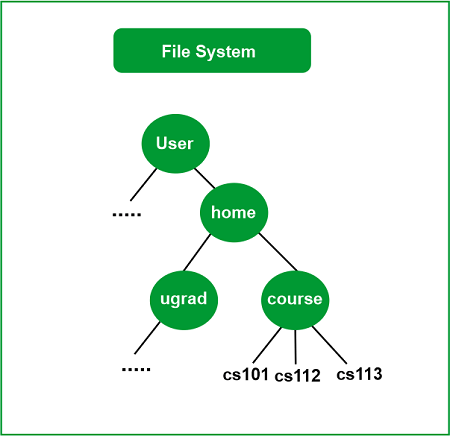Application of Binary Tree
The common non-linear data structure known as a tree. A tree illustrates a hierarchical structure in contrast to other data structures such an array, stack, queue, and linked list, which are linear in nature. A tree's ordering information is irrelevant. Two pointers and nodes make up a tree. The parent node's left and right children are represented by these two pointers. Let's thoroughly comprehend the words used in trees.
- The highest node in a tree that has no parent nodes is considered the root of the tree. Every tree has a single root node.
- Parent Node: A node's parent one is the node that came before it in the tree of nodes.
- Child Node: The node that is a node's direct successor is referred to as a node's child node.
- Siblings are the children of the same parent node.
- Edge: Edge serves as a connecting node between the parent and child nodes.
- Leaf: A node without children is referred to as a leaf node. It is the tree's last node. A tree may have several leaf nodes.
- A node's subtree is the tree that views that specific node as the root node.
- Depth: The depth of a node is the separation between it and the root node.
- Height: The height of a node is the distance between it and the subtree's deepest node.
- The maximum height of any node is referred to as the tree's height. The height of the root node is the same as this.
- Level: In the tree, a level is the number of parents that correspond to a particular node.
- Node degree: A node's degree is determined by how many children it has.
- A binary tree has (N+1) NULL nodes, where N is the total number of nodes in the tree.

Why use a tree-based data structure?
- You might wish to store information that naturally develops a hierarchy, which is one reason to use trees. For instance, a computer's file system:

- Trees offer reasonable access/search (with some ordering, like BST) (quicker than Linked List and slower than arrays).
- Trees offer limited insertion and deletion (quicker than Arrays and slower than Unordered Linked Lists).
- Because pointers are used to connect nodes, trees, like linked lists, have no maximum number of nodes.
The primary uses for tree data structures include:
- Manipulation of data in hierarchies.
- Make information searchable (see tree traversal).
- Manipulate data-sorted lists.
- For the purpose of composing digital pictures for visual effects.
- Routing protocols
- Multi-stage decision-making process type (see business chess).
What is a Binary Tree?
A binary tree is a tree data structure made up of nodes also known as left and right nodes-each of which has a maximum of two offspring. The tree starts at the root node.
Binary Tree Representation
Each node in the tree has the following information:
- Pointer to the left child
- Pointer to the right child
In C, we may use structures to represent a tree node. We may utilise classes as a component of other languages' OOP features. An illustration of a tree node containing integer data is shown below.
Application of Binary Tree
- Binary trees are applied in data compression methods in the form of the Huffman coding tree.
- Expression Trees, a binary tree application, are used in compilers.
- Another binary tree application that searches maximum or minimum in O(log N) time complexity is priority queue.
- Display data that is hierarchical.
- Utilized in spreadsheet and Microsoft Excel editing applications.
- Syntax trees are used by several well-known computer compilers, including GCC and AOCL, to execute arithmetic operations. They are helpful for indexing segmentation at the database and storing cache in the system.
- For putting priority queues into action.
- Utilized to provide quick memory allocation in computers (binary search tree) by finding items more quickly.
- Encoding and decoding operations
Binary tree Basic Operations
- Eliminating a component
- Looking for a component.
- Elimination of an element.
- Crossing a boundary. A binary tree has four (usually three) different forms of traversals, which will be covered in the following paragraphs.
Binary tree auxiliary operations
- Calculating the tree's height
- Determine the tree's level.
- Calculating the overall tree's size.
Binary Tree's benefits include
- A binary tree's searching process is incredibly quick.
- A binary tree can be represented in a straightforward and understandable way.
- It is effectively done to go from a parent node to its child node and vice versa.
- Simple to comprehend and apply.
- A pyramidal organization.
- The data set's structural links should be reflected
- Compared to data storage, inserting data is simple.
- Data storage in memory management is simple.
- The user can quickly execute numerous nodes.
- Arbitrary number of data values can be stored.
Binary Tree disadvantages:
- Many pointers in binary tree traversals are null and hence worthless.
- A Binary Search Tree (BST) access operation takes longer than an array access operation.
- Depending on the height of the tree, there are few basic options.
- Node deletion is difficult.
- The height of the tree is one simple choice.
|

 For Videos Join Our Youtube Channel: Join Now
For Videos Join Our Youtube Channel: Join Now










